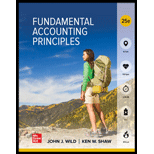
Periodic reporting C1
Choose from the following list of terms and phrases to best complete the statements below.
a. Fiscal year
b. Timeliness
C. Accrual basis accounting
d. Annual financial statements
e. Cash basis accounting
f. Time period assumption
- _______presumes that an organization's activities can be divided into specific time periods.
- Financial reports covering a one-year period are known as_______
- A(n)_______consists of any 12 consecutive months.
- _______records revenues when services are provided and records expenses when incurred.
- The value of information is often linked to its
Introduction:
The Periodic Reporting is a kind of reporting of transactions which a company does on a daily basis. These transactions are those which affects the financial status of the company.
To choose:
Select the best option
Answer to Problem 1QS
- Time period assumption presuming that an organisation's activities can be divided into specific time periods.
- Financial reports covering a one-year period are known as Annual Financial Statements.
- A(n) Fiscal Year consists of any 12 consecutive months.
- Accrual Basis Accounting records revenues when services are provided and Cash Basis Accounting records expenses when incurred.
- The value of information is often linked to its Timeliness.
Explanation of Solution
- Time period assumption / Periodicity Assumption- This assumption is used to divide the activities of a business into accouting periods i.e. week, month, quarter, etc.
- Annual Finnacial Statements − Financial Statements comprise of Balance Sheet, Statement of Profit or Loss and Cash Flow Statements. When these statements are prepared for a complete year, these are referred to as Annual Financial Statements.
- Fiscal Year - It consists of any 12 consequetive months. Accounting period varies from country to country. Some countries consider calender year i.e. January to December, as fiscal year whereas some consider financial year i.e. April to March, as fiscal year.
- Accrual basis accouting- This approach means transactions are recorder when actually incurred and not at the time when the receipts or payments in respect of those transactions take place (Cash basis accounting).
- Timeliness − It refers to the information provided to users of financial information on timely basis which can enable them to take decisions on time.
Cash basis accounting −In this approach, transaction are recorded in books of accounts when payments or receipts in respect of those transactions take place.
Conclusion:
The best terms of periodic reporting are mentioned for completing the incomplete/blank statements.
Want to see more full solutions like this?
Chapter 3 Solutions
FUND.ACCT.PRIN.
- I need help finding the accurate solution to this financial accounting problem with valid methods.arrow_forwardCan you explain this financial accounting question using accurate calculation methods?arrow_forwardI am looking for help with this financial accounting question using proper accounting standards.arrow_forward
- Accounting solutionarrow_forwardI need help with accountingarrow_forwardWhat are two double entries the following transaction? Account Receivable. Account payable. Rent Expenses. Cell phone bill, cable, light bill, gas, and monthly income of $4,000.00 what will be your net income after all expenses are paid. Please figure out your own price for each expense.arrow_forward
 Auditing: A Risk Based-Approach to Conducting a Q...AccountingISBN:9781305080577Author:Karla M Johnstone, Audrey A. Gramling, Larry E. RittenbergPublisher:South-Western College Pub
Auditing: A Risk Based-Approach to Conducting a Q...AccountingISBN:9781305080577Author:Karla M Johnstone, Audrey A. Gramling, Larry E. RittenbergPublisher:South-Western College Pub College Accounting (Book Only): A Career ApproachAccountingISBN:9781337280570Author:Scott, Cathy J.Publisher:South-Western College Pub
College Accounting (Book Only): A Career ApproachAccountingISBN:9781337280570Author:Scott, Cathy J.Publisher:South-Western College Pub Intermediate Accounting: Reporting And AnalysisAccountingISBN:9781337788281Author:James M. Wahlen, Jefferson P. Jones, Donald PagachPublisher:Cengage Learning
Intermediate Accounting: Reporting And AnalysisAccountingISBN:9781337788281Author:James M. Wahlen, Jefferson P. Jones, Donald PagachPublisher:Cengage Learning College Accounting, Chapters 1-27AccountingISBN:9781337794756Author:HEINTZ, James A.Publisher:Cengage Learning,Principles of Accounting Volume 1AccountingISBN:9781947172685Author:OpenStaxPublisher:OpenStax College
College Accounting, Chapters 1-27AccountingISBN:9781337794756Author:HEINTZ, James A.Publisher:Cengage Learning,Principles of Accounting Volume 1AccountingISBN:9781947172685Author:OpenStaxPublisher:OpenStax College





